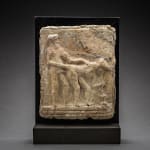Babylonian Erotic Scene, 2100 BCE - 1500 BCE
Terracotta
17.1 x 12.7 cm
6 3/4 x 5 in
6 3/4 x 5 in
SF.355
Further images
This baked clay plaque shows a man and woman copulating a tergo, while the woman bends over to drink alcohol through a large straw. Documentation from this period includes examples...
This baked clay plaque shows a man and woman copulating a tergo, while the woman bends over to drink alcohol through a large straw. Documentation from this period includes examples of erotic poetry, often correlating alcohol and sexual activity.
Ceramic baked plaques were mass-produced from moulds in Southern Mesopotamia from the second millennium BC, representing a wildly available art form. Casting plaques was a simple and inexpensive way to produce relief images since numerous plaques could be made from a single mould. They have been excavated in temples, as well as in household shrines of private homes.
Though their exact purpose is not clear, they may have been thought to possess magical or religious significance. Their subject matter varies widely, ranging from mythological imagery, erotic scenes, representations of rulers and gods, as well as other religious iconography.
Ceramic baked plaques were mass-produced from moulds in Southern Mesopotamia from the second millennium BC, representing a wildly available art form. Casting plaques was a simple and inexpensive way to produce relief images since numerous plaques could be made from a single mould. They have been excavated in temples, as well as in household shrines of private homes.
Though their exact purpose is not clear, they may have been thought to possess magical or religious significance. Their subject matter varies widely, ranging from mythological imagery, erotic scenes, representations of rulers and gods, as well as other religious iconography.





